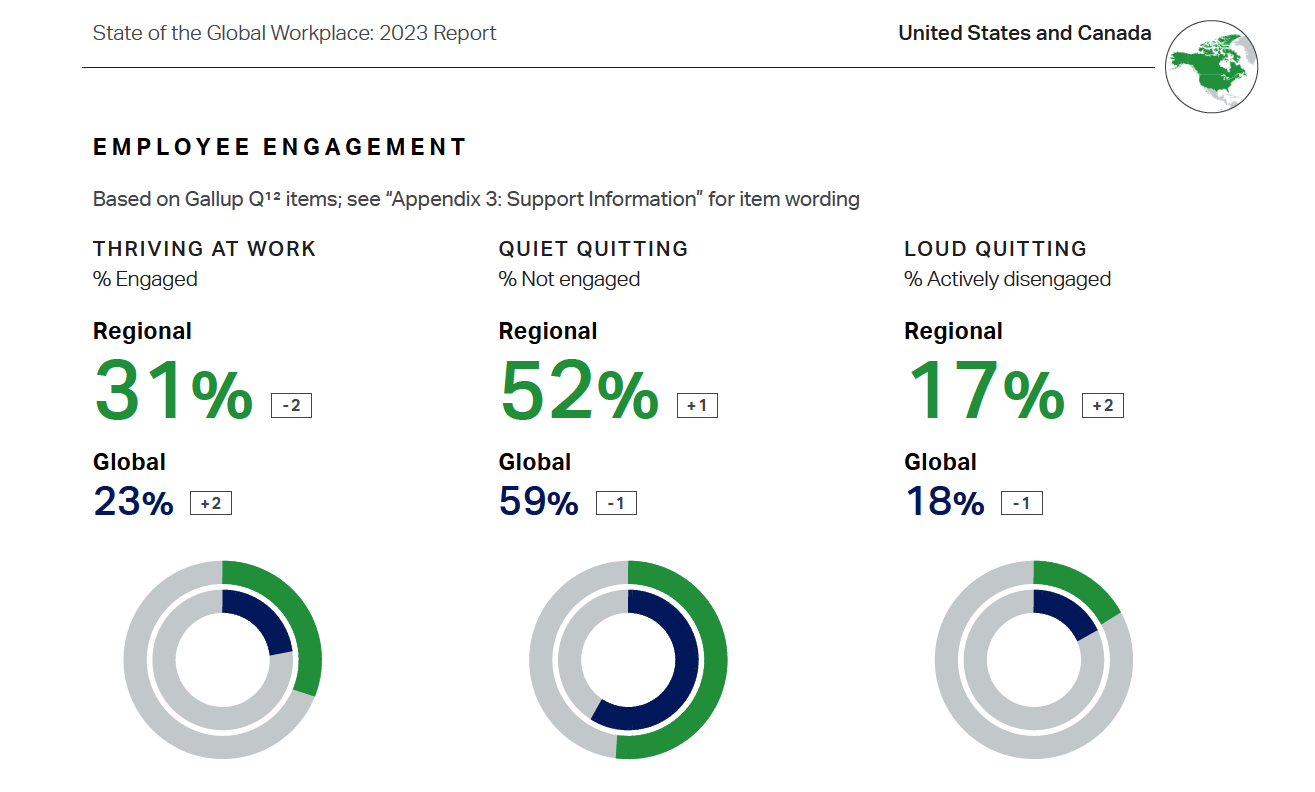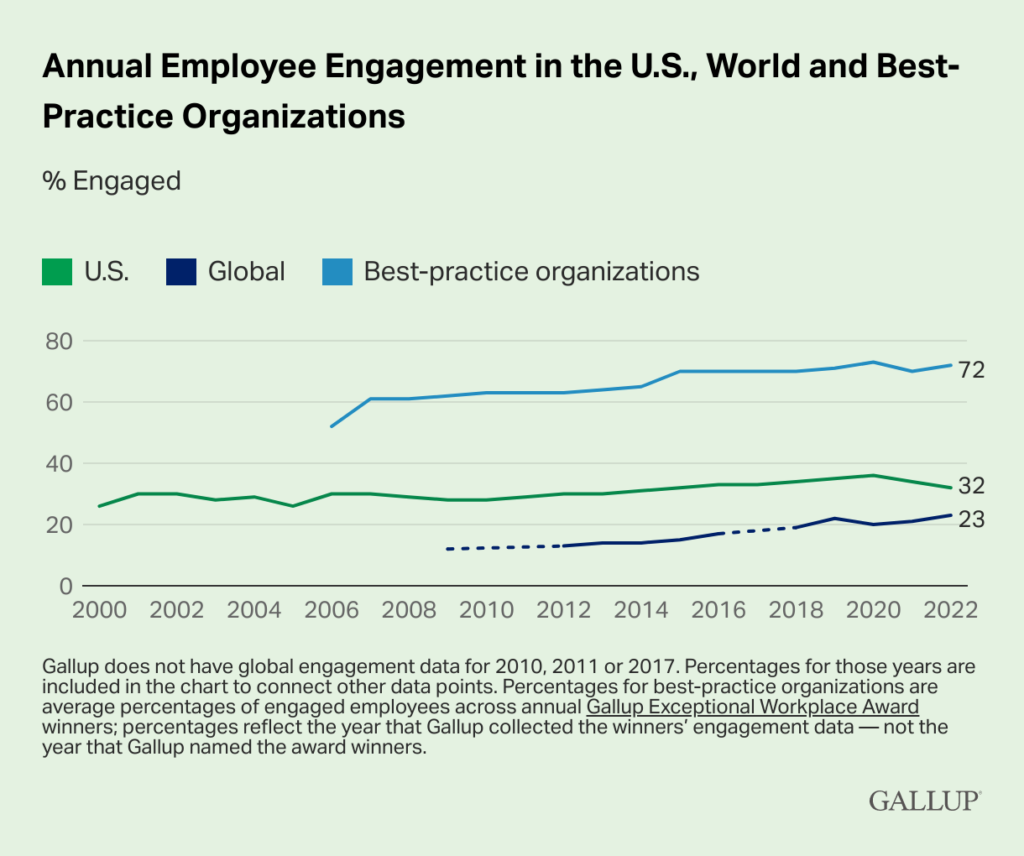Employee disengagement, often manifested through “quiet quitting,” is a prevalent global phenomenon affecting nearly 6 in 10 employees, as reported by Gallup in their “State of the Global Workplace: 2023 Report”.

When employees start feeling disconnected or uninterested in their work, it can spread like wildfire, affecting morale, productivity, and ultimately, your bottom line. That’s why it’s crucial for organizations to pay attention to subtle signs and address them proactively.
In this article, we’ll explore both the subtle signs of disengagement among employees and the crucial metrics for assessing potential disengagement and the risk of quiet quitting.
Disengagement can be subtle, but signs add up
Employee Engagement:
Two signs stand out. First, there’s a lack of initiative – employees aren’t jumping at new tasks or volunteering like they used to. Then, there’s social withdrawal, where they’re pulling back from team events and interactions.
Performance and Contribution:
A rise in absenteeism, characterized by frequent unexplained absences or increased sick leave, typically accompanies a deterioration in work quality. This is evident through missed deadlines and a general decline in performance standards. Additionally, the emergence of a negative attitude towards colleagues, tasks, or the organization contributes further to an overall decline in both performance and contribution within the workplace.
Adaptability, Communication, and Collaboration:
Employees may demonstrate resistance to change, showing reluctance to adapt to new processes or organizational shifts. This reluctance often coincides with a decline in expressing career ambition, as seen in diminished interest in advancement opportunities and minimal participation in discussions about professional growth. Moreover, decreased input in meetings and a passive presence without offering ideas or suggestions can further indicate a disconnect from team dynamics. Additionally, isolation from the team, whether physical or in terms of collaboration, along with changes in non-verbal cues like body language and engagement in conversations, underscores a broader issue.
External Indicators:
Negative feedback from clients or customers about responsiveness or service quality, coupled with a decline in customer satisfaction scores, points to a potential disconnect. Simultaneously, increased activity on job boards or professional networking sites, along with conversations about job opportunities with external contacts, signals a proactive exploration of alternatives.
These subtle signs of disengagement might seem small at first, but they can have a big impact on your team and the overall atmosphere of the workplace. Recognizing these signs early on is like catching a glitch in the system before it turns into a full-blown issue.
By staying alert to these subtle cues – whether it’s decreased communication, reduced initiative, or a general sense of apathy – you can nip potential problems in the bud. Engaged employees are more likely to be motivated, innovative, and committed to the success of the team.
So, next time you sense a shift in the air, take a moment to check in with your team members. A little bit of recognition and support can go a long way in keeping everyone engaged, motivated, and working towards a common goal.
Recognizing the small signs that employees might not be fully into their work is important for keeping the work vibe positive. But, when you’re looking after a big team, just relying on what you see on the surface might not be enough to tackle issues properly.
This is where implementing reliable systems becomes crucial for effectively tracking metrics that unveil employee disengagement. Setting up ways to monitor those early signs of team members feeling disengaged can be a game-changer, especially in preventing employees from quietly checking out.
While personalized one-on-one discussions are great for building connections and solving individual problems, incorporating systemic approaches adds another layer of support for boosting team spirit and keeping everyone motivated. It’s like having a safety net – it catches those not-so-obvious signs, making sure your team stays connected and productive.
Measuring the right metrics can help you keep an eye on behavior indicating quiet quitting

- Employee Engagement Surveys: Regularly survey job satisfaction to identify improvement areas. If you’re interested in learning how to use insights from employee surveys to drive business outcomes, consider Patrick Gallagher’s Employee Survey Analytics course.
- Turnover Rates: Track turnover trends for sudden spikes, indicating potential disengagement. This metric shows attrition trends and the HR effort in offboarding. Understand these numbers in the context of time and demographics to spot turnover anomalies. Combine this with exit surveys for deeper insight into departures and talent loss.
- Absenteeism Rates: Monitor for significant changes, as increased absences might signal disengagement. This metric displays the total employee absence days as a percentage of the total work days within a specific time frame (e.g. one year). It allows you to analyze trends in both planned and unplanned absences. For a more in-depth analysis of circumstances during employee’s leave, you can incorporate employee engagement metrics, such as our Employee Wellbeing survey.
- Performance Metrics: Track productivity, deadlines, and work quality for signs of decline. Ideally, you will monitor your employees’ performance to ensure that their compensation, recognition, and growth opportunities align with their efforts.
- Participation in Training: Assess engagement through participation in training programs. Utilizing attendance records, completion rates, and feedback surveys provides insights into the effectiveness of training initiatives and helps gauge overall employee engagement in professional development opportunities.
- Feedback and Recognition Metrics: Analyze programs to gauge satisfaction and identify undervalued employees. This involves assessing the effectiveness of feedback mechanisms and recognition initiatives to ensure they align with employee expectations and contribute to a positive workplace culture.
- Peer Reviews: Implement reviews for insights into team interactions and potential disengagement. This involves setting up a structured feedback system where team members can share observations, collaborate on strengths, and address potential challenges within the team dynamics.
- Career Path Progression: Monitor discussions on professional growth to identify a lack of ambition. Your company can monitor discussions on professional growth through regular one-on-one meetings between employees and supervisors. This includes integrating insights from performance reviews on commitment to skill development and utilizing employee surveys or feedback mechanisms to gauge overall sentiment and ambition within the organization.
- Employee Life Cycle: Measuring the employee life cycle gives you data-informed, contextualized insights you can use to deliver a better employee experience. Each employee journey is unique and people analytics tools help remove the guesswork and reduce the need for manual efforts from employee life cycle management.
- Time-to-Fill Positions: Prolonged fill times may indicate challenges in talent retention and engagement. For instance, if key roles remain unfilled for an extended period, it may lead to increased workload and decreased morale among existing team members, potentially affecting their engagement. Furthermore, a lengthened hiring process might result from a mismatch between organizational expectations and the current job market, requiring a reassessment of talent acquisition strategies to align with industry dynamics.
- Exit Reason Analysis: Analyze themes from exit interviews to address issues proactively. For instance, if multiple exits cite dissatisfaction with communication channels, your company can implement improved communication strategies. Similarly, if professional development opportunities emerge as a common factor, your company may refine its training programs to align with employee expectations.
- Employee Referral Rates: A decline in referrals may signal reduced engagement. If your company has a referral program in place, it’s essential to investigate the reasons behind the drop in employee referrals. Lack of engagement could be an indication that employees are not enthusiastic about recommending the workplace to their networks.
- Internal Mobility Rates: Tracking movements within the organization is essential for spotting signs of engagement. A lack of internal mobility may suggest employees are not finding opportunities for growth or challenge within the current structure.
- Benefits Utilization: Assess the utilization of benefits to understand overall employee engagement. Health and wellness benefits like gym memberships, mental health resources, or wellness programs, retirement savings plans, flexible work arrangements, and professional development opportunities may face underutilization and signal employees’ lack of awareness or appreciation.
- Managerial Effectiveness Metrics: A survey by DDI suggests that 57% of people quit because of their boss — and 37% reported that they’ve considered leaving because of their manager. Evaluating managerial effectiveness through team satisfaction, turnover rates, and feedback is important. A manager’s role is pivotal in influencing employee engagement, and these metrics offer a comprehensive view of leadership’s impact on team dynamics and overall organizational health.
Our approach to predictive analytics empowers you to anticipate potential disengagement
If this seems a bit daunting initially, no worries, we’ve got you covered. Monitoring indicators of disengagement across various platforms can certainly be a complex task. This is where having a centralized system becomes essential – and this is precisely the solution we provide.
At Orgnostic, we’re all about making this process smoother for you. Our tool is designed to streamline your data analysis, making it easier for you to make smart, informed decisions that benefit your team and your organization as a whole. Explore our Employee Turnover Models use case and learn how to implement a proactive approach to managing turnover. By analyzing data from multiple HR and financial sources, we help you identify turnover risk factors and predict which employees and teams are at the highest risk of leaving.